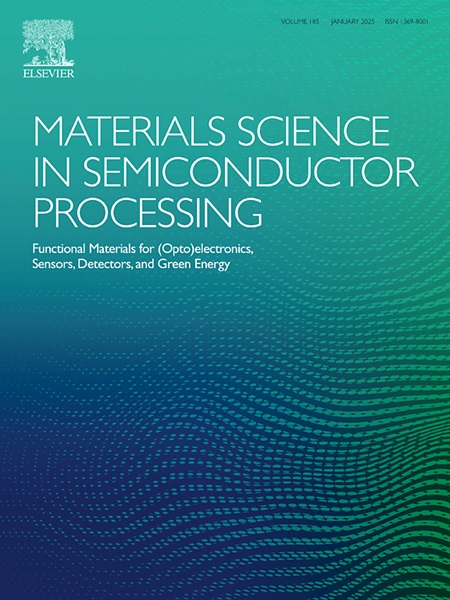FeNi2O4的载流子运动起源和双介电常数行为:介电共振、epsilon-near-zero、极化效应和可能的高级电磁应用
IF 4.6
3区 工程技术
Q2 ENGINEERING, ELECTRICAL & ELECTRONIC
引用次数: 0
摘要
氧化物材料中的负介电常数可以通过介电共振或等离子体振荡等机制实现,而正介电常数通常由各种极化效应产生。本研究采用自燃烧法合成了名义成分为FeNi2O4的尖晶石镍酸盐。由于介电极化和介电共振机制,材料表现出正、负介电常数行为。值得注意的是,FeNi2O4表现出可调谐的负介电常数,在10 MHz附近观测到的最大值为ε′≈−270,表明可能具有epsilon-近零(ENZ)行为。超过10 MHz, FeNi2O4表现出类似洛伦兹的介电常数响应,使其成为先进电磁应用(如超材料和微波吸收剂)的有希望的候选者。温度依赖性研究表明,温度升高会导致共振频率、介电常数大小的变化,并由于偶极子共振和自由电子动力学的共同作用而导致负介电常数行为的转变。为了理解FeNi2O4中的电输运机制,采用了各种传导模型。直流电导率测量证实了半导体行为,主要由电子和极化跳变过程控制。其中,非绝热小极化子跳变的活化能Ea = 1.01 eV,而Mott变程跳变(VRH)对应的无序能Ea = 0.377 eV。此外,Shklovskii-Efros (SE)型VRH传导是明显的,与约Δ = 1.2 eV的软库仑隙的形成有关。频率相关的电导率谱揭示了温度对阳离子相互作用和材料响应的影响。为了分析这些行为,实验数据使用Bruce的模型、Jonscher的普遍幂律和Summerfield标度形式来解释。在高频下,电导率趋势遵循超线性行为和近恒定损耗(NCL)模式。本文章由计算机程序翻译,如有差异,请以英文原文为准。
Carrier motion origins and dual-permittivity behavior in FeNi2O4: Dielectric resonance, epsilon-near-zero, polarization effects, and possible advanced electromagnetic applications
Negative permittivity in oxide materials can be achieved through mechanisms such as dielectric resonance or plasma oscillations, while positive permittivity typically arises from various polarization effects. In this study, a spinel nickelate with the nominal composition FeNi2O4 was synthesized using the auto-combustion method. The material exhibits both positive and negative permittivity behaviors, attributed to dielectric polarization and dielectric resonance mechanisms. Notably, FeNi2O4 demonstrates a tunable negative permittivity, with a maximum value of ε′ ≈ −270 observed around 10 MHz, suggesting the potential for epsilon-near-zero (ENZ) behavior. Beyond 10 MHz, FeNi2O4 exhibits a Lorentz-like permittivity response, making it a promising candidate for advanced electromagnetic applications such as metamaterials and microwave absorbers. Temperature-dependent studies reveal that increasing temperature leads to changes in resonance frequency, permittivity magnitude, and a transition in negative permittivity behavior due to the combined effects of dipole resonance and free electron dynamics. To understand the electrical transport mechanisms in FeNi2O4, various conduction models are employed. DC conductivity measurements confirm semiconducting behavior, primarily governed by electronic and polaronic hopping processes. Specifically, non-adiabatic small polaron hopping is characterized by an activation energy of Ea = 1.01 eV, while Mott's variable range hopping (VRH) corresponds to a disordered energy Ea = 0.377 eV. Additionally, Shklovskii–Efros (SE)-type VRH conduction is evident, associated with the formation of a soft Coulomb gap of approximately Δ = 1.2 eV. The frequency-dependent conductivity spectra reveal that cationic interactions and material response are influenced by temperature. To analyze these behaviors, experimental data are interpreted using Bruce's model, Jonscher's universal power law, and the Summerfield scaling formalism. At high frequencies, the conductivity trends follow superlinear behavior and the nearly constant loss (NCL) regime.
求助全文
通过发布文献求助,成功后即可免费获取论文全文。
去求助
来源期刊

Materials Science in Semiconductor Processing
工程技术-材料科学:综合
CiteScore
8.00
自引率
4.90%
发文量
780
审稿时长
42 days
期刊介绍:
Materials Science in Semiconductor Processing provides a unique forum for the discussion of novel processing, applications and theoretical studies of functional materials and devices for (opto)electronics, sensors, detectors, biotechnology and green energy.
Each issue will aim to provide a snapshot of current insights, new achievements, breakthroughs and future trends in such diverse fields as microelectronics, energy conversion and storage, communications, biotechnology, (photo)catalysis, nano- and thin-film technology, hybrid and composite materials, chemical processing, vapor-phase deposition, device fabrication, and modelling, which are the backbone of advanced semiconductor processing and applications.
Coverage will include: advanced lithography for submicron devices; etching and related topics; ion implantation; damage evolution and related issues; plasma and thermal CVD; rapid thermal processing; advanced metallization and interconnect schemes; thin dielectric layers, oxidation; sol-gel processing; chemical bath and (electro)chemical deposition; compound semiconductor processing; new non-oxide materials and their applications; (macro)molecular and hybrid materials; molecular dynamics, ab-initio methods, Monte Carlo, etc.; new materials and processes for discrete and integrated circuits; magnetic materials and spintronics; heterostructures and quantum devices; engineering of the electrical and optical properties of semiconductors; crystal growth mechanisms; reliability, defect density, intrinsic impurities and defects.
 求助内容:
求助内容: 应助结果提醒方式:
应助结果提醒方式:


